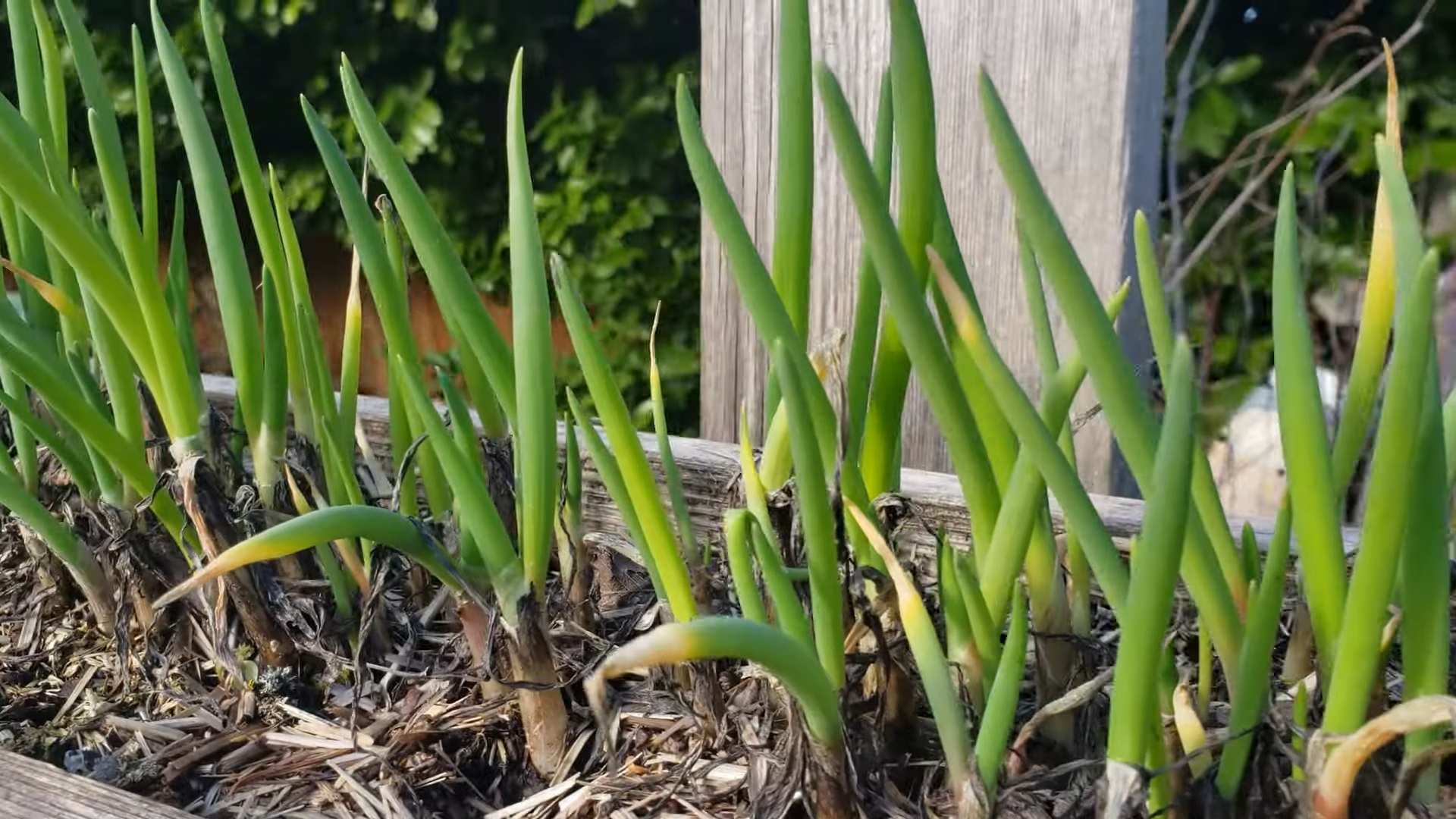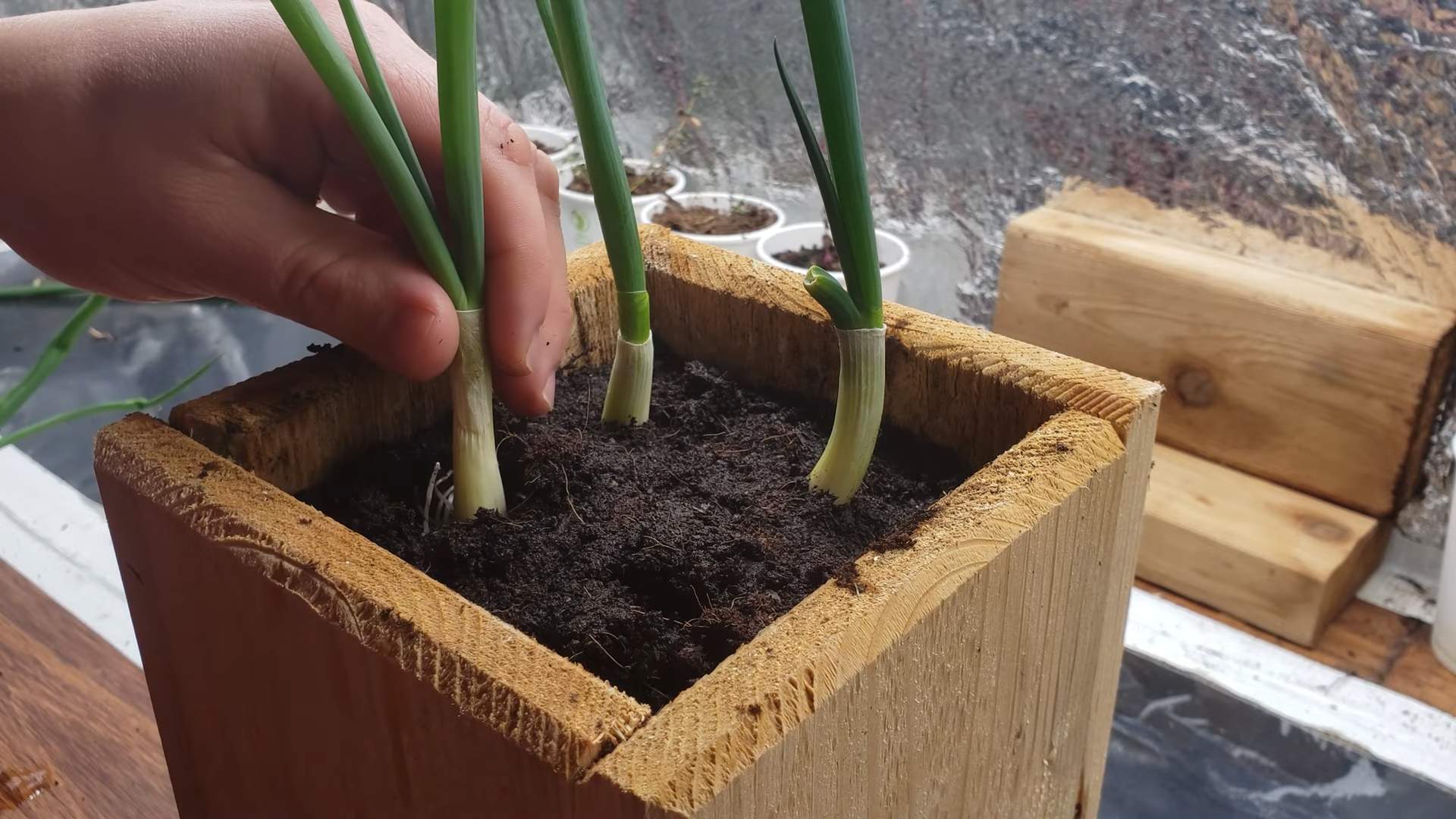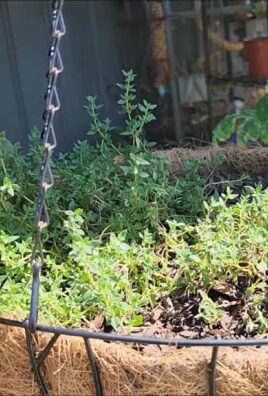Growing green onions from scraps is easier than you might think, and I’m here to show you how! Have you ever tossed the root ends of your green onions, thinking they were useless? Well, stop right there! You’re throwing away a potential endless supply of fresh, flavorful green onions. For generations, resourceful gardeners have utilized this simple technique to minimize waste and maximize their harvest. This isn’t just a modern trend; it’s a time-honored tradition of making the most of what you have.
In many cultures, particularly in Asian cuisine, green onions are a staple ingredient. From garnishing soups and salads to adding a zesty kick to stir-fries, they’re incredibly versatile. But buying them from the store every week can add up, and sometimes you only need a little bit. That’s where this DIY trick comes in!
Imagine always having fresh green onions at your fingertips, ready to add a burst of flavor to your meals. No more last-minute trips to the grocery store or wilting bunches in the fridge. Growing green onions from scraps is not only cost-effective and convenient, but it’s also incredibly rewarding. It’s a fantastic way to reduce food waste, connect with nature, and enjoy the satisfaction of growing your own food, even in a small space. So, let’s dive in and discover how to transform those discarded scraps into a thriving green onion patch!

Growing Green Onions From Scraps: A Beginner’s Guide
Hey there, fellow gardening enthusiasts! Ever find yourself tossing the root ends of your green onions after using the leafy tops? Stop right there! You’re throwing away potential for endless green onion goodness. I’m going to show you how to regrow green onions from those scraps, saving you money and adding a touch of green to your kitchen. It’s super easy, even if you don’t have a green thumb. Trust me, if I can do it, you can too!
What You’ll Need
Before we dive in, let’s gather our supplies. This is a pretty low-key project, so you probably already have most of this stuff:
* Green onion scraps (the white part with the roots attached)
* A glass or jar
* Water
* Potting soil (optional, but recommended for long-term growth)
* A small pot or container (optional, for planting in soil)
* A sunny windowsill or grow light
The Water Propagation Method
This is the easiest and quickest way to get started. It’s perfect for beginners and lets you see the roots grow, which is pretty cool.
1. Prepare the Scraps: After using your green onions, cut off the white part, leaving about 1-2 inches from the root end. Make sure the roots are still attached. If the roots are really long, you can trim them slightly, but don’t cut them off completely!
2. Find the Right Container: Grab your glass or jar. It should be tall enough to hold the green onion scraps upright without them tipping over. A small mason jar or even a recycled glass works perfectly.
3. Add Water: Fill the glass with enough water to cover the roots, but don’t submerge the entire white part of the onion. You want the top of the white part to be exposed to air to prevent rotting.
4. Place the Scraps in Water: Carefully place the green onion scraps in the glass, root-end down. Make sure they are stable and won’t fall over.
5. Find a Sunny Spot: Place the glass on a sunny windowsill or under a grow light. Green onions need sunlight to grow, so the more light they get, the better.
6. Change the Water Regularly: This is important! Change the water every 1-2 days to prevent bacteria growth and keep the water fresh. This will also help the roots grow faster.
7. Watch Them Grow!: Within a few days, you should start to see new green shoots emerging from the top of the scraps. The roots will also start to grow longer. It’s so satisfying to watch!
8. Harvesting: Once the green shoots are a few inches long, you can start harvesting them. Just snip off the amount you need with scissors. The green onions will continue to grow, so you can harvest them multiple times.
Transplanting to Soil (For Long-Term Growth)
While you can continue to grow your green onions in water, transplanting them to soil will give them more nutrients and allow them to grow larger and stronger. This is what I recommend for a more sustainable supply.
1. Choose a Pot: Select a small pot or container with drainage holes. Green onions don’t need a huge pot, so something around 4-6 inches in diameter is perfect.
2. Prepare the Soil: Fill the pot with good-quality potting soil. You can also add some compost to the soil to give your green onions an extra boost of nutrients.
3. Make a Hole: Use your finger or a small tool to make a hole in the soil that is deep enough to accommodate the roots of the green onion scrap.
4. Carefully Remove the Scrap from Water: Gently remove the green onion scrap from the water, being careful not to damage the roots.
5. Plant the Scrap: Place the green onion scrap in the hole, making sure the roots are covered with soil. The white part of the onion should be partially buried, but the green shoots should be above the soil.
6. Water Thoroughly: Water the soil thoroughly after planting. Make sure the water drains out of the drainage holes.
7. Place in a Sunny Spot: Place the pot on a sunny windowsill or under a grow light.
8. Water Regularly: Keep the soil moist, but not soggy. Water when the top inch of soil feels dry to the touch.
9. Fertilize (Optional): You can fertilize your green onions every few weeks with a diluted liquid fertilizer to encourage growth.
10. Harvesting: Just like with the water method, you can harvest the green shoots as needed by snipping them off with scissors. The green onions will continue to grow and produce new shoots.
Tips and Tricks for Success
Here are a few extra tips to help you get the most out of your green onion growing adventure:
* Use Fresh Scraps: The fresher the green onion scraps, the better the chances of them regrowing. Try to use them as soon as possible after cutting them.
* Don’t Overwater: Overwatering can lead to root rot, so be careful not to water too much. Let the soil dry out slightly between waterings.
* Provide Enough Light: Green onions need plenty of light to grow, so make sure they are in a sunny spot or under a grow light.
* Rotate Your Crops: If you’re growing multiple green onions, rotate them every few weeks to ensure they all get enough light.
* Pest Control: Green onions are generally pest-resistant, but you may occasionally encounter aphids or other pests. If you do, you can spray them with a mild solution of soapy water.
* Experiment with Different Varieties: There are many different varieties of green onions, so experiment with different ones to see which ones you like best.
* Successive Planting: To ensure a continuous supply of green onions, start new scraps every few weeks. This way, you’ll always have fresh green onions on hand.
* Observe and Adjust: Pay attention to how your green onions are growing and adjust your care accordingly. If they are not growing well, try moving them to a different location or adjusting your watering schedule.
* Don’t Be Afraid to Experiment: Gardening is all about experimentation, so don’t be afraid to try new things. You might be surprised at what you discover.
* Enjoy the Process: Growing your own green onions is a fun and rewarding experience. Take the time to enjoy the process and appreciate the fresh, homegrown flavor.
Troubleshooting
Sometimes, things don’t go exactly as planned. Here are a few common problems you might encounter and how to fix them:
* Yellowing Leaves: This could be a sign of overwatering, underwatering, or lack of nutrients. Check the soil moisture and adjust your watering schedule accordingly. You can also try fertilizing your green onions.
* Slow Growth: This could be due to lack of light or nutrients. Make sure your green onions are in a sunny spot and fertilize them regularly.
* Root Rot: This is caused by overwatering. If you notice the roots are turning brown or mushy, reduce your watering and make sure the pot has good drainage. You may need to replant the green onion in fresh soil.
* Pests: If you see pests on your green onions, spray them with a mild solution of soapy water. You can also try using insecticidal soap or neem oil.
Why Grow Your Own Green Onions?
Besides being incredibly easy and cost-effective, growing your own green onions has several other benefits:
* Freshness: You can’t beat the taste of freshly harvested green onions. They are much more flavorful than store-bought ones.
* Convenience: Having a constant supply of green onions right in your kitchen is incredibly convenient. You’ll never have to run to the store just for a few green onions again.
* Sustainability: Regrowing green onions from scraps is a great way to reduce food waste and live more sustainably.
* Educational: Growing your own food is a great way to learn about plants and the environment.
* Therapeutic: Gardening can be a very therapeutic and relaxing activity.
So there you have it! Everything you need to know to start growing your own green onions from scraps. It’s a simple, rewarding, and sustainable way to add fresh flavor to your meals. Happy growing!

Conclusion
So, there you have it! Transforming those humble green onion scraps into a never-ending supply of fresh, flavorful goodness is not just a fun project; it’s a game-changer for your kitchen and your wallet. We’ve walked you through the simple steps, highlighting the ease and efficiency of this sustainable practice. But why is this DIY trick a must-try?
Firstly, it drastically reduces food waste. Think about all those green onion ends you’ve tossed in the trash over the years. Now, imagine them thriving in a glass of water, ready to add a burst of freshness to your next meal. It’s a small change with a significant impact on reducing your environmental footprint.
Secondly, it’s incredibly convenient. No more last-minute trips to the grocery store just for a few sprigs of green onion. With your own little green onion farm growing on your windowsill, you’ll always have fresh herbs at your fingertips. This is especially useful for those spontaneous culinary creations or when you realize you’re missing that one crucial ingredient.
Thirdly, it’s cost-effective. While the initial investment of buying green onions is minimal, the savings add up over time. By regrowing your green onions, you’re essentially getting free herbs, week after week. Think of all the other delicious ingredients you can buy with the money you save!
But the benefits don’t stop there. This project is also incredibly rewarding. Watching those little scraps sprout and grow is a satisfying experience, especially for those with a green thumb (or those who aspire to have one!). It’s a simple way to connect with nature and appreciate the magic of plant life.
Now, let’s talk about variations. While water propagation is the easiest method, you can also transplant your regrown green onions into soil for even more robust growth. Simply transfer the rooted scraps to a pot filled with well-draining soil, and watch them flourish. You can even experiment with different types of containers, from repurposed jars to decorative planters.
Another variation is to try growing other types of alliums from scraps, such as leeks or scallions. The process is similar, and you might be surprised at the results. Just remember to provide adequate sunlight and water for optimal growth.
This DIY green onion growing trick is more than just a fun experiment; it’s a sustainable, convenient, and cost-effective way to add fresh flavor to your meals. It’s a small step towards a more eco-conscious lifestyle, and it’s a project that anyone can do, regardless of their gardening experience.
So, what are you waiting for? Grab those green onion scraps, find a glass of water, and get growing! We encourage you to try this DIY trick and share your experiences with us. Post photos of your thriving green onion gardens on social media using #RegrowGreenOnions and let us know what delicious dishes you’re creating with your homegrown herbs. We can’t wait to see your results! Let’s all embrace the joy of sustainable cooking and create a greener, more flavorful world, one green onion at a time.
Frequently Asked Questions (FAQ)
How long does it take for green onions to regrow from scraps?
Typically, you’ll start to see new growth within a few days. Within a week or two, you should have enough green onion to harvest. The speed of growth depends on factors like sunlight, water quality, and temperature. Warmer temperatures and ample sunlight will encourage faster growth.
What part of the green onion do I need to regrow it?
You need the white bulb end with the roots attached (or the potential for roots to grow). Cut off the green tops, leaving about 1-2 inches of the white base intact. This base contains the root system and the energy needed for regrowth.
How often should I change the water?
It’s best to change the water every 1-2 days. This helps prevent bacterial growth and keeps the water fresh, which is essential for healthy root development. Stagnant water can lead to rot and hinder growth.
How much sunlight do regrowing green onions need?
Green onions thrive in bright, indirect sunlight. Place them near a sunny windowsill where they can receive at least 6 hours of sunlight per day. If you don’t have a sunny windowsill, you can supplement with a grow light.
Can I regrow green onions in soil instead of water?
Yes, you can! Once the roots have grown a few inches in water, you can transplant the green onion scraps into a pot filled with well-draining soil. Bury the white bulb end, leaving the green shoots exposed. Water regularly, keeping the soil moist but not waterlogged.
How often should I water green onions grown in soil?
Water thoroughly when the top inch of soil feels dry to the touch. Avoid overwatering, as this can lead to root rot. Ensure the pot has drainage holes to prevent water from accumulating at the bottom.
How do I harvest regrown green onions?
Simply snip off the green tops as needed, leaving about an inch or two of the green shoots intact. This will allow the green onions to continue growing. Avoid cutting too much at once, as this can weaken the plant.
How many times can I regrow green onions from the same scraps?
You can regrow green onions from the same scraps multiple times, but the growth will eventually slow down. After several harvests, the bulb may become depleted of nutrients. At this point, it’s best to start with fresh scraps.
Can I use tap water to regrow green onions?
Yes, you can use tap water, but it’s best to let it sit out for 24 hours to allow the chlorine to evaporate. Alternatively, you can use filtered water or rainwater.
What if my green onions start to turn yellow or brown?
Yellowing or browning leaves can indicate several issues, such as overwatering, underwatering, lack of sunlight, or nutrient deficiency. Adjust your watering schedule, ensure adequate sunlight, and consider adding a diluted liquid fertilizer to the water or soil.
Can I grow green onions indoors year-round?
Yes, you can grow green onions indoors year-round, as long as you provide them with adequate sunlight and water. They are relatively low-maintenance plants and can thrive in a variety of indoor environments.
Are there any pests or diseases that affect regrowing green onions?
Green onions are generally pest-resistant, but they can occasionally be affected by aphids or other small insects. If you notice any pests, you can wash them off with a strong stream of water or use an insecticidal soap. Root rot can also be a problem if the soil is too wet.
Can I use this method to grow other types of onions?
While the method works best with green onions, you can also try it with scallions and leeks. The success rate may vary, but it’s worth experimenting to see what works best for you.
What are the best uses for regrown green onions?
Regrown green onions can be used in a variety of dishes, such as salads, soups, stir-fries, and omelets. They add a fresh, mild onion flavor to any dish. You can also use them as a garnish for tacos, nachos, and other appetizers.
Is it safe to eat regrown green onions?
Yes, it is perfectly safe to eat regrown green onions, as long as they are grown in clean water or soil and are free from pests and diseases. Wash them thoroughly before using them in your cooking.




Leave a Comment